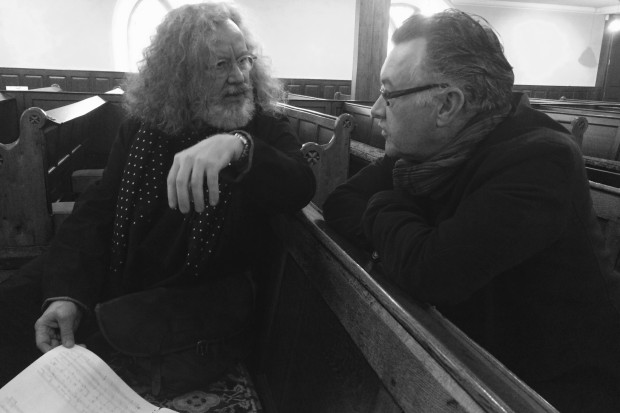
Martin Hayes and the Common Ground Ensemble at the NCH. (Photo: John Meagher)
A Voice His Own, Rarely Alone
Martin Hayes’ new group, the Common Ground Ensemble, seems to wear its name as a mission statement. There’s a political element, of course, and a viewpoint: seeking harmony in a divided world.
Naturally there’s more to it than that. Although the group emphasises traditional music, its five central members come from a variety of fields: traditional (Hayes and Brian Donnellan, who plays bouzouki, concertina, and harmonium); jazz and improvised music (pianist Cormac McCarthy and New York guitarist Kyle Sanna); and contemporary classical (cellist Kate Ellis). The group had their first Irish performances at the National Concert Hall last weekend, the 26th and 27th of March.
The performers’ individual styles can be felt, but they’re never the forefront. Throughout the performance, there was a sense of the tune as the driving and the unifying force, and even when the music ventured into the realms of atonal harmony and extended techniques, or jazzier harmony, the primacy of the original music was still clear. This is no cheap fusion.
The ensemble exists partly as a vehicle for collaboration, and two guest performers were present: the sean-nós singer Síle Denvir and uilleann piper David Power. Each performed twice – once near the start and once near the end – with Denvir’s performance of the romantic song ‘Eleanor na Rún’ and a lullaby, ‘Pota Mór Fataí’, her voice clear and passionate over the group’s chiming accompaniment. Power’s performances were more integrated with the group, including a slow and sweet-toned march, ‘Lord Mayo’, followed by two reels, ‘The Knotted Chord’ and ‘The Star of Munster’.
Halfway through the concert, Hayes introduced a pair of pieces that the group used to explore a wider and stranger timbral palette. Expanding and expounding on the idea of blue notes, they took ‘O’Carolan’s Farewell to Music’ and slowly introduced contemporary classical techniques – Ellis playing with the tip of her bow, Sanna’s guitar strings bent and tense, McCarthy’s left hand inside the piano, damping the melody played by his right. As these effects compounded, you got the impression you were being pulled through the music, like Alice through the looking glass. And on the other side lay ‘Garrett Barry’s Jig’, the context alone making it sound surreal.
‘You weren’t meant to enjoy that at all,’ Hayes quipped afterwards, as the heavy applause subsided. ‘It was meant to be disturbing.’ I thought it was the most enjoyable piece of the night.
Hayes is a born collaborator, drawing other skilled musicians into orbit around him. Most famous is The Gloaming, but there’s also the Martin Hayes Quartet, Triúr, and duet collaborations with David Power and guitarist Dennis Cahill, among others. Indeed the core of this group (Hayes, McCarthy and Donnellan) has already performed in the National Concert Hall, in a live-streamed concert in December 2020.
And so working with musicians from within and without traditional music is nothing new to Hayes. Through these collaborations he has developed a distinctive, highly polished sound. His voice is a paradox: uniquely his but rarely his alone.
The individual musicians of the ensemble carry the character of their own playing into the group. Hayes’ fiddling is crisp and clear, McCarthy’s piano crystalline and nimble, and Ellis’ cello full and warm. Sanna and Donnellan largely played support roles, although both were given a true moment in the spotlight during the encore.
But it wasn’t the solos that stood out. It was their sound as a group. The instruments blended beautifully, forming such a cohesive acoustic that it was often hard to pinpoint a certain sound to a certain instrument. The opening emphasised this strength, with the air ‘Aisling Gheal’, which morphed into the hornpipe ‘Johnny Cope’ and then ‘Hugh Travers’ Reel’. Hayes began alone, soon joined by Ellis and McCarthy, and as the piece progressed, the musicians performed in a variety of combinations. It was rarely the timbre of a single instrument that was felt, but how they worked together.
And that sentence (I realise as I write it) strikes at the heart of Hayes’ concept for the group. It’s right there in the name. And while traditional Irish music is the medium through which they’re performing, their backgrounds and styles differ. They find common ground through working together. Or as Hayes put it, just before playing a tune derived from ‘The Boyne Water,’ an Orange march, ‘melody is melody, just like humanity is humanity.’
This was seven highly skilled and self-assured musicians, drawn from different backgrounds but playing utterly in their element.
For upcoming concerts, visit www.martinhayes.com/concerts.
Published on 31 March 2022
Brendan Finan is a teacher and writer. Visit www.brendanfinan.net.

















